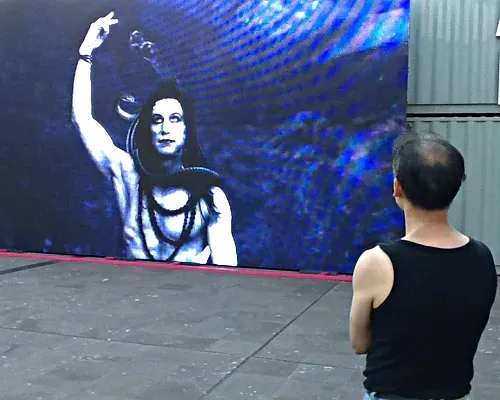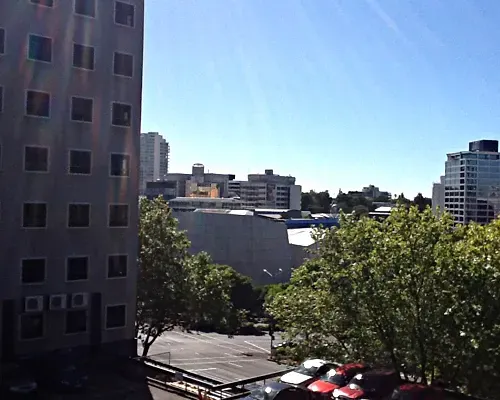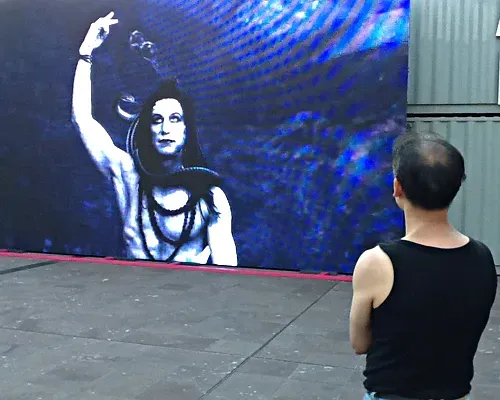The Fest Test: The View
Written by

The latest Auckland Arts Festival blog from Mark Amery.
8am
My hotel is next to the Auckland Central Police Station. I look down from my window into their car park. This doesn't comfort me, it slightly freaks me out.
I can look across to Aotea Square. There, aged 16 in the mid 80s I was in the crowd in a concert when the police suddenly appeared in their riot gear and effectively stirred up a riot. The lawn mower catcher hood of the Aotea Centre was where Cook Street Markets had stood, a rabbit warren community of street sellers, infused with the smell of 70s incense. It revealed to me that Auckland was about far more than the Burbs. To the right, if there wasn't a hotel blocking the view, I would see The Basement Theatre. Here back in the 80s I helped my father rip out the old skanky nightclub carpets to create Auckland Youth Theatre. We did theatre exercises to the soft moans of porn films in the Classic Cinema above our heads.
The police station came with stories of the brutality of the 81 tour, the 70s Dawn Raids on Pacific Islanders, and legends of people being hung out the windows by their ankles until they confessed. The grey tower looked down on all I held dear like Big Brother in George Orwell's 1984. While beautiful old buildings got ripped down all over town it stayed solid as a fortress.
Today the Square is full of festive spirit. There is Tiffany Singh's glorious installation of Tibetan style flags that contain school children's hopes and dreams, the festival club, and the giant colourful and sumptuous projection of images of Indian Gods in Srinivas Krishna's videowork. Krishna and Singh would have felt right at home at Cook Street Market.
At Q Theatre, the stunning new addition in my window landscape, next to the Basement and Town Hall, the Kila Kokonut Krew bring back memories of the Dawn Raids with their musical The Factory. Sharp and strong as a tack, it has been immaculately reworked for the Festival since its debut in Mangere in 2011, a credit to the Krew's growth and the Festival's role in development. Tama Waipara and a crack hot funky band have clearly made a significant contribution to boot.
In this beautiful new theatre this production is a symbol of how far Auckland theatre has come. Ironically then, the production values and set remind me of the musicals I saw at the Mercury in the 80s. Indeed featuring in a note perfect performance is a young name from those days Ross Girven, both arsehole attitude and vulnerability as a Pakeha factory owner who treats his Pacific Island workers like slaves. The character is written too cartoon-like in its racism, but Girven works wonders with the material.
The power of this work is in its all-round superb performances and, in particular, the choral basis for much of the roof-lifting singing. Lead in what is very much a collective work is Milly Grant-Koria as Losa, the recent immigrant from Samoa who falls in love with the factory owner's son. She has a most beautiful voice and gentle stage presence. One other special mention must go to Lindah Lepoh, factory queen, who really anchors the drama and acts a bridge for the audience with panache and subtlety.
Bring to all this a melding of traditional and contemporary Samoan performance, the KKK's wicked sense of humour and some seriously funky disco moves and you have some very special twists on the musical genre. My feelings however were also a little mixed. The story and songs are not at their best when they themselves are slavish to the American musical form. Musically there are still times when this could be Grease meets West Side Story, and the whole star crossed lovers and bad factory boss threads could be dealt with far more subtly. It needn't be blindingly obvious what's going to happen next. I also missed the live band's presence on stage, something else that would have nicely messed with the musical genre's Western roots. The Factory really soars when it breaks and reshapes the forms we're overly familiar with.
I write this on Pasifika weekend, and what is particularly special about The Factory is its telling for a broad general audience of the troubling situation for Pacific Islanders when they arrived by their thousands in Auckland in the 70s. This is history too easily forgotten amongst the celebrations of the day, and worth musing on when we consider how we treat migrant workers today. The Factory deserves a big long life which sees it seen by thousands more New Zealanders, and beyond.
Today I also note is the last day of the Auckland Fringe Festival. Apologies to Arthur, Victor, Hannah, Yvette and Tom, I missed your shows. With 115 shows and something like 40 venues the programme's amazing scope reminds me of the Wellington Fringe back 15 years ago. My loss. Auckland's arts scene is clearly in rude health.

